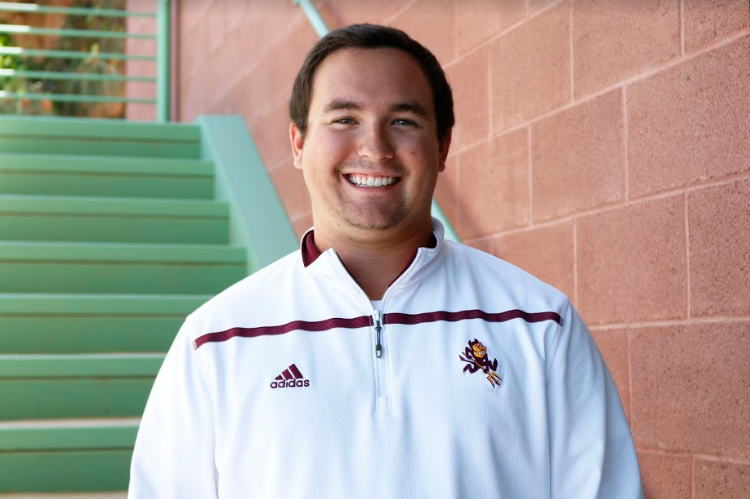
Article reposted from The State Press
Author: Joe Jacquez
Growing up around both sports and medicine, John Teasley loves the job that now allows him to combine both: ASU women’s tennis athletic trainer.
Teasley said his mom worked in a hospital. As a kid, science and medicine intrigued him, but he also loved to play sports. Out of high school, he made the wrestling and golf teams, but Teasley’s playing career ended before it really could get started.
“During my freshman year of high school, I tore my meniscus in my right knee and had to have surgery,” Teasley said. “I saw the athletic trainer and that is where I found the job that combines sports and medicine. It is funny because that is the typical story of how many athletic trainers got into the job.”
While he misses playing sports, Teasley said he was never the best golfer or wrestler, but he understood both sports. He also has a solid understanding of tennis that helps him dissect why a player cramps up after hitting a certain shot.
Teasley said he loves helping athletes get back out on the court after an injury, something he’s done extensively with ASU women’s tennis. This makes the day-to-day grind of guiding players through rehab worth it. Currently, Teasley is helpingsenior Kassidy Jump work back from a right knee injury.
“At the end of the day, that is why I do this job,” Teasley said. “To see somebody that has an injury not be able to play the sport that they love, work with them through the rehab, because everybody hates rehab and nobody has fun with that. But, to see them go through it and then see them play just as good as they were before, that makes me happy.”
Teasley was first exposed to athletic training as an undergrad for three years at Michigan State. During his senior year as a Spartan, Teasley applied for a variety of graduate internship programs.
In November 2014, Teasley applied to ASU. After the application process concluded, he interviewed with the tennis coaching staff. Before graduating from Michigan State in May 2015, Teasley accepted a full-time graduate assistant position at ASU.
The Michigan native knew he wanted to get away from the snow, and ASU women’s tennis was looking for a new athletic trainer.
“The weather played a huge part,” Teasley said. “For 23 years, I was in the snow and I was like ‘forget that’ so I decided to come to the desert.”
Teasley realized early on that effective communication would make the job easier at ASU. On a daily basis, he has to talk with players, coaches, doctors and administrators about how all six players are feeling.
“He (Teasley) knows how the kids are feeling and a way to get it out of them,” head coach Sheila McInerney said. “He travels with us on the road and that is really helpful for a coach. It takes some of the pressure off us, as far of who can go and who can’t go.”
As an athletic trainer, he does not officially diagnosis injuries, but he can provide an opinion to the coaching staff. McInerney needs to know the status of an injured player because that effects practice plans and the lineup for singles and doubles.
“Sheila wants the facts and she wants it right away,” Teasley said. “So it is about how do I go about that and tell her in a way that makes the most sense.”
When a player is injured, Teasley is required to go to the doctor’s office for the medical examination. Part of his job is to explain to players what the doctor’s diagnosis means and how long they will be out. Teasley’s great relationships with all the players helps ease this stressful process.
“There is a lot of times where they come out of those appointments and say to me ‘so, what is going on?’” Teasley said. “For doctors, the medical terminology is just second nature.”
Earlier this season, sophomore Sammi Hampton reinjured her shin at the Texas Tech Invitational. During her doctor’s appointment, Hampton said Teasley did a great job of explaining the injury and what the recovery process would entail.
From day one, Teasley wanted every player to feel comfortable in his training room. When Hampton was rehabbing, he started with lighter conversations about her weekend or classes. Teasley said this helped put Hampton in a better mood and allowed him to ask about her injury.
Hampton said he has always had her back. She said he texted her every day to check in on her injury and kept her company while she was sitting out.
“You want someone that is going to be there for everything, not just your injuries,” Hampton said. “He knows when something is wrong, even if it isn’t about tennis and will talk with you about it and that helps me play better.”
Teasley will finish his graduate assistant program after the season ends. If a full-time position opens up, he said he would take it in a heartbeat.
“I get paid whether we win or lose,” Teasley said. “I am not here for that. I am here to make sure that the athletes are safe and healthy and at the same time, doing what we can to get them on the court to play because that is what they want.”